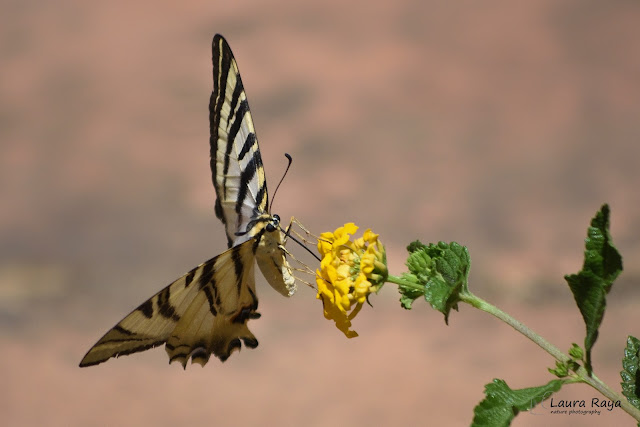Chupaleches, así se conoce vulgarmente a la Iphiclides podalirius feisthamelii. Pertenece a la familia Papilionidae, al igual que la Papilio machaon que yá vísteis en este post: Post Papilio machaon.
Las orugas de ambas especies disponen de osmeterium, un órgano proyectable por el que excretan sustancias de sabor desagradable con el fin de defenderse frente a depredadores. Las crisálidas son de tipo cinguladas y los imagos presental escaso dimorfismo sexual.
Seguro que se os ha cruzado alguna vez porque sus 70 mm de envergadura y su amplia distribución permiten verlas entre marzo y noviembre con relativa asiduidad. Son especialmente abundantes en Junio, en lugares secos y soleados y frecuentemente en frutales y bordes de caminos, ya que su planta nutricia es el género Prunus (cerezos, ciruelos, almendros, etc). También piruétanos y majuelos.
Los machos tienen un comportamiento de hilltopping, y os preguntaréis ¿qué es eso? Pues se trata de un enfrentamiento en forma de batallas que consiste en vuelos en vertical y persecución de los intrusos que intentan invadir la zona. El que alcanza el lugar más alto es considerado el mejor para la reproducción por la hembra.
Lamentablemente es una especie en declive, posiblemente como consecuencia de la aplicación de insecticidas en cultivos de frutales.
Esto es todo por hoy! Nos vemos en instagram, facebook y twitter!
Mil besos!
L.R.
Chupaleches, this is commonly known as the Iphiclides podalirius feisthamelii. It belongs to the family Papilionidae, like the Papilio machaon that you saw in this post: Post Papilio machaon.
The caterpillars of both species have osmeterium, a projectable organ by which they excrete substances of unpleasant taste in order to defend itself against predators. The pupae are cingulate type and the imagos presse scarce sexual dimorphism.
It is sure to have crossed you some time because its 70 mm in size and its wide distribution allow to see them between March and November with relative assiduity. They are especially abundant in June, in dry and sunny places and frequently in fruit trees and roadsides, since its nutritious plant is the genus Prunus (cherry, plum, almond, etc.).
The males have a behavior of hilltopping, and you will think...what is that? It is a confrontation in the form of battles that consists of vertical flights and chase the intruders who try to invade the area. The one who reaches the highest place is considered the best for reproduction by the female.
Unfortunately it is a declining species, possibly as a consequence of the application of insecticides in fruit crops.
That is all for today! See you in instagram, facebook and twitter!
Kisses!
L.R.






No hay comentarios:
Publicar un comentario